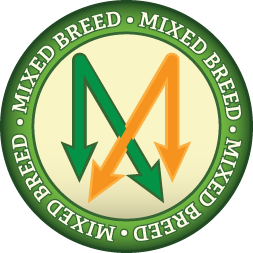
- Activity Level: high
- Grooming Level: low
- Trainability: moderate
- Adaptability: moderate
- Kid/Pet Friendly: often
- Prey Drive: high
- Watchdog: aware
- Average Size: Medium
- Average Lifespan: 12-15 years
Irish Setter Mix Dog Breed Information
Overview
Temperament
Adaptability
Health
Owner Experience
Grooming
Activity Level
Size
Life Span
The Irish Setter Mix is a cross between an Irish Setter and another dog breed. In any mixed dog breed, the puppies can take on any combination of characteristics from one or both of the parent breeds.
On the Irish Setter side, you have a loving, playful, and energetic dog that is intelligent and active. The other dog breed in the cross can make a difference in what to expect in your Irish Setter Mix puppy. So, it’s important to talk to the breeder about the other parent breed in the mix to get a full picture of what you could expect.
If the Irish Setter Mix takes after their Irish Setter parent, they’ll be energetic, playful, and make a great family pet. Irish Setters tend to get along well with children and other dogs. They tend to have a high prey drive, so they will require more socialization with smaller pets in the household.
You can expect something similar from your Irish Setter Mix puppy. However, you still want to ask the breeder about the other parent in the cross as it can affect what traits your Irish Setter Mix puppy could inherit.
Depending on the other breed in the cross, your Irish Setter Mix could be a highly adaptable dog breed. However, the Irish Setter is a high-energy dog and needs room to run, so they tend to be moderately adaptable. They don’t tend to do well in apartments.
They also do not like to be left alone for long periods of time, but they do well in just about any climate. You’ll want to be prepared for that in an Irish Setter Mix and know what you might expect from the other parent breed in the cross.
Although a mixed breed can sometimes “win the genetic lottery” and not develop any breed-specific health issues, there is no guarantee that could happen. An Irish Setter Mix could inherit the potential for health conditions common to one or both of the parent breeds.
On the Irish Setter side, potential health concerns to be aware of include allergies, cancer, epilepsy, hypothyroidism, deafness, and sensitivities to certain types of drugs. You’ll want to ask the breeder about the other parent breed in the cross as well as about the genetic history of both parents. You can also ask to see any relevant health clearances or test results to help allay potential health concerns.
The Irish Setter is an intelligent, energetic dog that tends to get bored easily. Although they pick up on things quickly and are eager to please, they can be a challenge for first-time dog owners. Depending on the other parent breed in the cross, an Irish Setter Mix could be moderately trainable like their Irish Setter parent or could be more highly trainable or more difficult to train.
Because there may be variation in the trainability of an Irish Setter Mix, novice or first-time dog owners should be prepared to enroll in puppy training and obedience classes. Even if you have experience as a dog owner, puppy training classes can still be a good idea and can also provide some opportunities to socialize a puppy.
The other parent breed in the cross may affect the coat type and care required for your Irish Setter Mix, so you’ll want to have a conversation with the breeder about it. If the Irish Setter Mix takes after their Irish Setter parent, they’ll have a longer coat that can tangle easily. They’ll need brushing a few times a week and the occasional bath. And, they’ll have a double coat that will shed moderately all year with two heavier shedding sessions as the seasons change.
Regardless of coat type, there are other grooming tasks you’ll need to do to keep your dog comfortable and healthy. You will need to care for your Irish Setter Mix’s nails, ears, and teeth. Monthly nail trimming is usually enough to keep nails from getting too long. But, if they aren’t wearing down as much naturally or they just grow quickly, you may need to cut your dog’s nails more often.
It’s also important to check and carefully clean your dog’s ears as needed to help prevent ear infections. Checking weekly to make sure ears are dry, clean, and free of debris is usually sufficient to keep an eye on things. You also need to take care of your dog’s teeth. Brushing your dog’s teeth or using an enzyme toothpaste every day is ideal dental care for dogs. It keeps your dog’s teeth and gums healthy and helps reduce the chance that they will develop painful dental diseases later in life.
Because the Irish Setter is a high-energy dog breed, you will need to be prepared for the same in an Irish Setter Mix. The other parent breed could result in a lower energy dog, but you can’t rely on that.
You’ll need to be prepared for long, daily walks and some playtime with time to run every day. The good news is that your Irish Setter Mix will be happy to be with you being active, so you can try a lot of different activities to figure out what you both like to do best. You can teach your dog how to play frisbee, try going swimming, go on hikes with them, or even train for dog sports. They may not be able to compete in official competitions, but they’ll likely have a blast learning how to do it.
An Irish Setter usually stands 22-26 inches tall and weighs 50-70 pounds. The size of an Irish Setter Mix can be affected by the other parent breed, so make sure you ask the breeder about it. Meeting the mother dog can also give you a good idea of what size to expect in your Irish Setter Mix puppy.
An Irish Setter generally lives 12-15 years, but the other parent breed could affect this range for your Irish Setter Mix. Talking to the breeder about the other parent breed can help you get an idea of what to expect.







